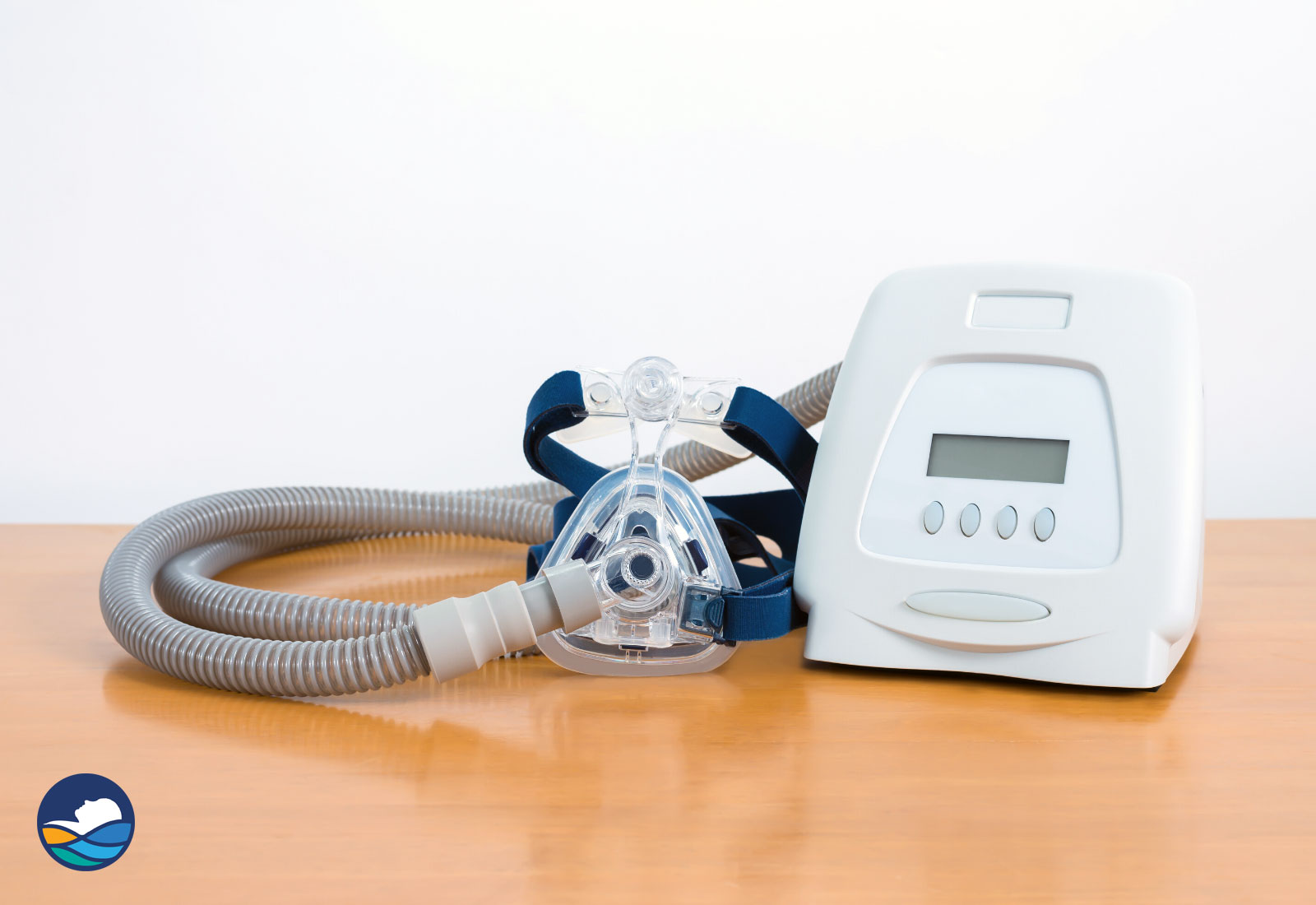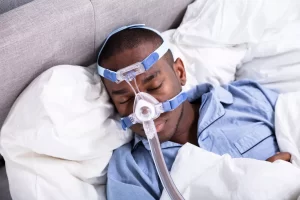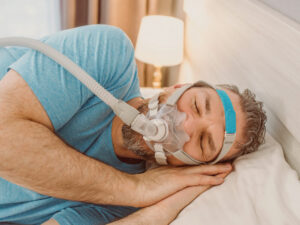Are you looking for relief from sleep apnea? CPAP and BiPAP are two treatments that can help. But what’s the difference between them? In this article, we’ll explain how CPAP and BiPAP work and the main differences between them to help you decide which one is best for you.
Sleep apnea is a common disorder that affects millions of people across the globe. It occurs when breathing repeatedly stops and starts during sleep, leading to fatigue, interrupted sleep, and other health problems. Fortunately, CPAP (Continuous Positive Airway Pressure) and BiPAP (Bilevel Positive Airway Pressure) are two treatments available that can provide relief from the symptoms of this condition. But what’s the difference between these two treatments?
CPAP works by providing a steady stream of air pressure through a mask while you sleep, while BiPAP delivers air at two levels – one higher pressure when inhaling, and a lower pressure when exhaling – to make breathing easier. In this article, we’ll explore the similarities and differences between CPAP and BiPAP in depth to help you decide which treatment option is right for you. So let’s take a closer look!
Overview Of CPAP And BiPAP
CPAP and BiPAP are two forms of positive airway pressure (PAP) therapy used to treat sleep apnea. CPAP stands for continuous positive airway pressure, while BiPAP is short for bilevel positive airway pressure. Both therapies provide pressurized air to keep the patient’s airway open during sleep. However, there are some important differences between them.
CPAP provides a steady stream of pressurized air that keeps the patient’s airway open at all times. The user wears a mask connected to an airflow generator that produces the pressurized air, which is then delivered through a tube and into the mask. The one-level pressure of CPAP can be adjusted depending on the severity of the user’s sleep apnea.
BiPAP works differently than CPAP in that it uses two different levels of pressure: one for inhalation (IPAP) and one for exhalation (EPAP). IPAP is set at a higher level than EPAP, allowing for easier breathing during inhalation and more efficient exhalation. As with CPAP, users wear a mask connected to an airflow generator, but BiPAP also includes an adjustable expiratory relief feature that can be set according to comfort level or oxygen needs.
Both CPAP and BiPap are effective treatments for sleep apnea and can help reduce symptoms such as snoring, daytime fatigue, and difficulty concentrating. However, patients should talk to their doctor about which device is right for their particular condition. Each person’s situation is unique and should be considered when choosing the most appropriate form of PAP therapy.
Main Differences Between CPAP And BiPAP
The main difference between CPAP and BiPAP lies in the type of air pressure each machine produces. CPAP machines produce a single, constant level of air pressure throughout the night, while BiPAP machines produce two different levels: an inhale pressure and an exhale pressure.
Another key difference is how these machines treat sleep apnea. CPAPs work by providing enough airway pressure to keep the airway open all night long, while BiPAPs use a higher inhale pressure to open up the throat and then use a lower exhale pressure to make breathing more comfortable. This makes BiPAPs better at treating more severe cases of sleep apnea than CPAPs are.
Finally, one may also find that they prefer one machine over the other depending on their individual needs. For instance, those with issues such as COPD or congestive heart failure may find that the lower exhale settings provided by a BiPAP are more comfortable than those of a CPAP machine. Conversely, some people may feel that CPAP’s single-level setting is easier to adjust to and more comfortable for them overall. Ultimately, it is important for individuals to discuss which machine is best for them with their doctor before making a decision about which one is right for them.
Benefits Of BiPAP Over CPAP
BiPAP, or bilevel positive airway pressure, is a type of ventilation therapy used to treat sleep apnea. It is different from CPAP, or continuous positive airway pressure, in that it provides two levels of pressure to the user. The higher pressure helps the user breathe in and the lower pressure helps them breathe out. This difference between BiPAP and CPAP allows for a more comfortable experience for those with sleep apnea.
One of the main benefits of BiPAP over CPAP is that it can provide relief from breathlessness during sleep. Many people find traditional CPAP machines uncomfortable because they must constantly keep their mouth open to receive the necessary airflow. With BiPAP, however, users can adjust the pressure settings so that they can breathe more comfortably while sleeping.
The second benefit of BiPAP over CPAP is that it can help reduce snoring and other breathing-related issues associated with sleep apnea. By providing two levels of pressure, users are able to maintain a steady flow of air throughout their breathing cycle which can help reduce snoring and improve overall breathing quality during sleep. Additionally, some people may find that using a BiPAP machine helps them fall asleep faster than they would with traditional CPAP machines alone.
BiPAP systems also tend to be easier to use and maintain than traditional CPAP machines due to their adjustable settings and intuitive design. This makes them ideal for those who are new to sleep apnea treatments as well as experienced users looking for an easier way manage their condition. Overall, using a BiPAP machine is often seen as an effective way to treat sleep apnea without compromising on comfort or convenience.
Disadvantages Of BiPAP
BiPAP has several downsides that need to be considered before deciding if it is the right therapy for you. Firstly, BiPAP machines are bulkier and more expensive than CPAP machines. They can cost up to twice as much and require a special mask to fit properly. Additionally, the masks can be uncomfortable for some users due to their size and fit.
BiPAP machines also tend to be noisier than CPAPs and may make it harder for you or your partner to get an uninterrupted night’s sleep. Furthermore, BiPAP devices require more frequent cleaning and maintenance than CPAPs, which can be time consuming and inconvenient.
Finally, although BiPAP is an effective treatment option that can help many people with sleep apnea, it comes with a risk of side effects such as dry mouth, skin irritation from the mask, headaches and nausea. For this reason it’s important to discuss the pros and cons of both CPAP and BiPAP with your doctor before making a decision about which is best for you.
Which Is Stronger – CPAP Or BiPAP?
CPAP stands for Continuous Positive Airway Pressure and is a treatment used to treat sleep apnea. It works by delivering pressurized air into the patient’s airway, which helps keep the throat open while they sleep. BiPAP stands for Bilevel Positive Airway Pressure, and it is similar to CPAP but with a few key differences. BiPAP is more complex than CPAP and can deliver two different levels of pressure when breathing in and out. This allows for more control over the air pressure delivered to the patient.
When it comes to deciding which of these treatments is stronger, it really depends on the individual patient’s needs. Generally speaking, CPAP is better suited for milder cases of sleep apnea, while BiPAP may be more suitable for those with moderate or severe sleep apnea. The amount of pressure needed will depend on how severe the sleep apnea symptoms are and how much air flow resistance there is in the airways.
Ultimately, your doctor will be able to help you determine which treatment option would be best for you based on your specific needs and lifestyle factors. Your doctor may also suggest a combination of both treatments if necessary. With proper guidance from your doctor, you can find an effective treatment plan that works best for you and your condition.
Advantages For Sleep Apnea Patients With CPAP Or BiPAP
Now that we have established the differences between CPAP and BiPAP, let’s discuss the advantages of these treatments for sleep apnea patients.
CPAP is a common treatment for mild to severe forms of sleep apnea. This type of device delivers continuous positive airway pressure (CPAP) to keep the airway open while sleeping. The main advantage of using CPAP is that it helps reduce snoring and can prevent breathing pauses throughout the night. It also helps reduce daytime sleepiness, improve quality of life and reduce other health risks associated with sleep apnea.
BiPAP is another form of treatment for those with more severe sleep apnea. This type of device delivers two levels of air pressure to keep the airway open during sleep: an inhale pressure and an exhale pressure. The benefits include improved oxygen levels in the blood stream, less snoring, fewer breathing pauses throughout the night and improved quality of life overall.
Both CPAP and BiPAP can be helpful treatments for people with sleep apnea, depending on their individual needs. For example, if someone has milder case of sleep apnea then CPAP may be sufficient; however, for more severe cases BiPAP could be a better option as it provides two levels of pressure to better keep the airway open during sleep. Ultimately, it is important to consult a doctor or specialist when deciding which type of treatment is best suited for each individual patient’s needs.
Pros And Cons Of CPAP Vs BiPAP
CPAP and BiPAP are two popular treatments for sleep apnea. Both treatments provide positive air pressure to the patient’s airway to help keep it open during sleep. Although they are similar in function, there are some key differences between them.
CPAP, or Continuous Positive Airway Pressure, is a single-level of pressurized air that is delivered through a mask to the patient’s nose and/or mouth. CPAP is often the first line of treatment for mild to moderate obstructive sleep apnea. It is relatively simple to use, has few side effects, and is less expensive than other options. However, CPAP can be uncomfortable for some patients due to the constant stream of air pressure.
BiPAP, or Bilevel Positive Airway Pressure, also delivers pressurized air through a mask but at two different levels: one higher level when inhaling and a lower level when exhaling. This makes it easier to breathe while wearing the mask compared to CPAP and may be more comfortable for some patients who have difficulty tolerating the higher pressures of CPAP therapy. BiPAP is usually recommended for those with more severe sleep apnea or underlying medical conditions such as COPD or neuromuscular diseases. Additionally, because BiPAP requires more sophisticated equipment than CPAP, it tends to be more expensive.
Choosing between CPAP and BiPAP should be discussed with your doctor based on your individual needs and medical condition. The right one for you will depend on how consistent you are able to maintain your therapy as well as any comfort considerations related to your particular situation.
Does Either Device Provide Oxygen?
Moving on from the pros and cons of CPAP vs BiPAP, a pertinent question is whether either device provides oxygen. The answer is yes, both devices can provide supplemental oxygen.
CPAP involves the delivery of pressurized air to the patient through a mask, which helps keep the airway open during sleep. It does not deliver direct oxygen but increases the level of oxygen in the blood by increasing overall air pressure in the lungs so that more oxygen-rich air is inhaled.
BiPAP, on the other hand, uses two different levels of pressure – one for inhalation and one for exhalation – to even out breathing patterns and ensure that sufficient amounts of oxygen are delivered to the lungs. It also helps improve airflow and reduce sleep apnea episodes.
So, while CPAP does not deliver direct oxygen to a patient’s bloodstream, it can increase its overall concentration in the body. BiPAP, however, is designed specifically to deliver higher concentrations of oxygen directly into the lungs with each breath so that patients get more oxygen throughout their treatment sessions.
Is BiPAP Considered Life Support?
BiPAP, or Bilevel Positive Airway Pressure, is a type of non-invasive ventilator used for people who have difficulty breathing. It helps to keep the airways open by delivering two different levels of air pressure; one for inhalation and one for exhalation. But is BiPAP considered life support?
The answer is yes and no. While it does provide a level of ventilation, it is not considered life support in the same way as an invasive ventilator. BiPAP is designed to help patients breathe more easily and reduce their workload while they sleep. It also helps with some cases of obstructive sleep apnea (OSA). Although it can be used with OSA patients who require more advanced ventilation than CPAP (Continuous Positive Airway Pressure) can provide, it should not be relied upon as a long-term solution or be used as a substitute for an invasive ventilator.
BiPAP can provide temporary relief to those suffering from chronic respiratory failure or COPD (Chronic Obstructive Pulmonary Disease), but should not be used as a permanent form of life support. In these cases, a doctor should assess the patient’s condition and discuss further options with them before starting BiPAP therapy. Ultimately, if your doctor believes that BiPAP is necessary to maintain your health, then it has been determined that it can be considered life support in certain circumstances.
How Does BiPAP Affect Oxygen Levels?
CPAP and BiPAP are two types of continuous positive airway pressure (CPAP) therapy used to treat sleep apnea. CPAP involves a single pressure setting, whereas BiPAP offers two different settings, one for inhalation and one for exhalation. In addition, BiPAP also provides higher levels of pressure during inhalation than CPAP does.
BiPAP can affect oxygen levels in two ways. First, the increased pressure helps keep the airways open, allowing more oxygen-rich air to enter the lungs and reduce hypoxia (low oxygen levels). This improved airflow means more oxygen is available to reach the bloodstream, resulting in higher oxygen saturation levels in your body. Additionally, because the machine cycles between inhalation and exhalation at a faster rate than normal breathing, it can help you take in more oxygen with each breath.
In addition to helping increase oxygen levels throughout your body, using BiPAP may also help reduce respiratory acidosis—the accumulation of acid in your blood due to prolonged periods of shallow or slow breathing. This can be beneficial for people who experience difficulty breathing due to COPD or other chronic conditions. As such, BiPAP may be an effective treatment option for those seeking relief from sleep apnea or other breathing problems.
Is The Purpose Of Bipap Ventilation Or Oxygenation?
The main difference between CPAP and BiPAP is the purpose of each. CPAP stands for Continuous Positive Airway Pressure, and it is designed to provide a constant flow of air into the airways in order to keep them open. BiPAP stands for Bilevel Positive Airway Pressure, and its primary purpose is ventilation, not oxygenation.
BiPAP works by alternating between two levels of pressure – one higher than the other – in order to give the patient more time to exhale and take a breath. This helps reduce the amount of work put on the respiratory system, resulting in a better quality of life for those who need assistance with their breathing due to sleep apnea or COPD. It also gives patients who experience difficulty breathing during sleep additional time to exhale and inhale, which can improve their overall health.
BiPAP machines are typically used for conditions such as chronic obstructive pulmonary disease (COPD), congestive heart failure (CHF), sleep apnea, neuromuscular diseases, and post-surgical care. They may also be used for people who require extra oxygen during sleep due to an underlying medical condition or lifestyle choices such as smoking or living in high altitudes. In these cases, supplementation with supplemental oxygen may be necessary alongside BiPAP use in order to ensure optimal blood oxygen levels are achieved.
BiPAP machines can be beneficial for those who suffer from chronic respiratory conditions as they can help reduce symptoms such as shortness of breath while providing a comfortable level of ventilation. They are also helpful for those who need additional support with their breathing due to underlying medical conditions or lifestyle choices that compromise their ability to breathe normally during sleep.
Factors To Consider When Choosing Between Devices
When it comes to choosing between CPAP and BiPAP devices, there are several factors to consider. First, one must consider the extent of their sleep apnea or other medical condition. The severity of a person’s condition usually determines which device is most effective for them. For example, someone with moderate to severe sleep apnea might benefit more from a BiPAP machine than a CPAP machine.
The second factor to consider is comfort level while using the device. Both machines offer adjustable settings and features, but some may be more comfortable than others. Additionally, those who have allergies or sensitivities may need a particular type of mask or filter in order to use the device comfortably.
Finally, cost is an important factor when it comes to choosing between CPAP and BiPAP devices. Generally speaking, BiPAP machines tend to be more expensive than CPAP machines due to their additional features and functions. However, it’s important to understand that the cost should not be the only factor when selecting a device; finding the right fit for one’s needs should take priority over cost considerations.
Choosing between CPAP and BiPAP devices can be challenging, especially since both types are designed for different purposes and levels of need. It’s important to evaluate one’s individual needs and how they will interact with each type of machine before making a final decision.
Possible Complications From Using A Device
Using a CPAP or BiPAP device can be beneficial in treating sleep apnea, but it’s important to understand that there are potential complications involved. The most common complication is skin irritation due to the mask used with the device. This issue can be addressed by using a different type of mask, such as a nasal pillow or full face mask. Another possible complication is dryness of the nose and throat due to the air pressure being delivered from the machine. To combat this problem, a heated humidifier should be used in conjunction with a CPAP or BiPAP device.
In addition, some people may experience headaches after wearing their device for extended periods of time. This may be caused by poor fitting of the mask or incorrect adjustment of the machine settings. If this occurs, it’s important to adjust both and see if it helps reduce any discomfort. It may also be necessary to switch masks entirely if one type does not work for you.
Lastly, it’s important to note that some people may have difficulty adapting to sleeping with a mask on their face. This can lead to feelings of claustrophobia and anxiety while using the device. If this occurs, talk with your doctor about ways to make wearing your device more comfortable and bearable.
Tips For Successful Treatment With A Device
So, what are the differences between CPAP and BiPAP and how can you ensure successful treatment with a device? CPAP stands for Continuous Positive Airway Pressure and is used to treat sleep apnea. The machine delivers a constant flow of air that helps keep your airway open throughout the night. BiPAP stands for Bilevel Positive Airway Pressure, which is similar to CPAP but provides two different levels of pressure: one higher pressure when inhaling and a lower pressure when exhaling. This helps those with more severe sleep apnea symptoms to get better sleep at night.
When using either type of machine, it’s important to follow the doctor’s instructions on how to use it properly and adjust settings if needed. It’s also vital to clean the equipment regularly and replace any worn-out parts. Additionally, make sure you have a comfortable mask that fits correctly; otherwise, it can be difficult to get used to wearing it during sleep. Lastly, establish a regular bedtime routine that includes winding down before going to bed and having regular wake times each day so your body gets used to its new sleep routine.
With these tips in mind, you’ll be ready for successful treatment with your device! Be sure to follow all instructions provided by your doctor or healthcare provider and make any necessary adjustments as needed. With patience and perseverance, you’ll soon be getting the restful sleep you need each night.
Summary
CPAP and BiPAP are two treatments for sleep apnea that use air pressure to keep the airways open. CPAP stands for continuous positive airway pressure and is a single-level of pressure that is delivered throughout the night. BiPAP stands for bilevel positive airway pressure and uses two levels of pressure, one higher and one lower, which alternate during the night.
The main difference between CPAP and BiPAP is that with CPAP, only one level of pressure is used while with BiPAP, two levels are used. CPAP is usually used as a first-line treatment for mild to moderate sleep apnea while BiPAP may be recommended if a patient has moderate to severe sleep apnea or other breathing disorders such as COPD or asthma.
BiPAP can also be helpful for people who have difficulty adjusting to using CPAP due to its lower pressure settings. It can also help reduce snoring and improve sleep quality. Ultimately, your doctor will recommend the best treatment option based on your individual needs and preferences.
Conclusion
In conclusion, CPAP and BiPAP are both effective treatments for sleep apnea. Both devices can provide relief from the debilitating effects of the disorder, but there are some important differences to consider when deciding which one is right for you. CPAP is a single-pressure device that delivers a steady stream of air pressure to the patient’s airways. BiPAP is a dual-pressure device that alternates between two different pressures, allowing for more precise control over the amount of air delivered to the patient’s airways. BiPAP also offers more options in terms of customization and comfort than CPAP does.
When choosing between CPAP and BiPAP, it’s important to weigh your own individual needs against the pros and cons of each device. Your doctor can provide valuable advice about which device may be best for you, as well as discuss possible complications that could arise from using either device. With proper education and adherence to treatment plans, both CPAP and BiPAP can provide excellent relief from sleep apnea.
It’s important to remember that no matter which device you choose, compliance with treatment is essential in order to reap all the benefits sleep apnea therapy has to offer. With dedication and support from healthcare professionals, you can successfully manage your sleep apnea symptoms and lead a healthier life.




